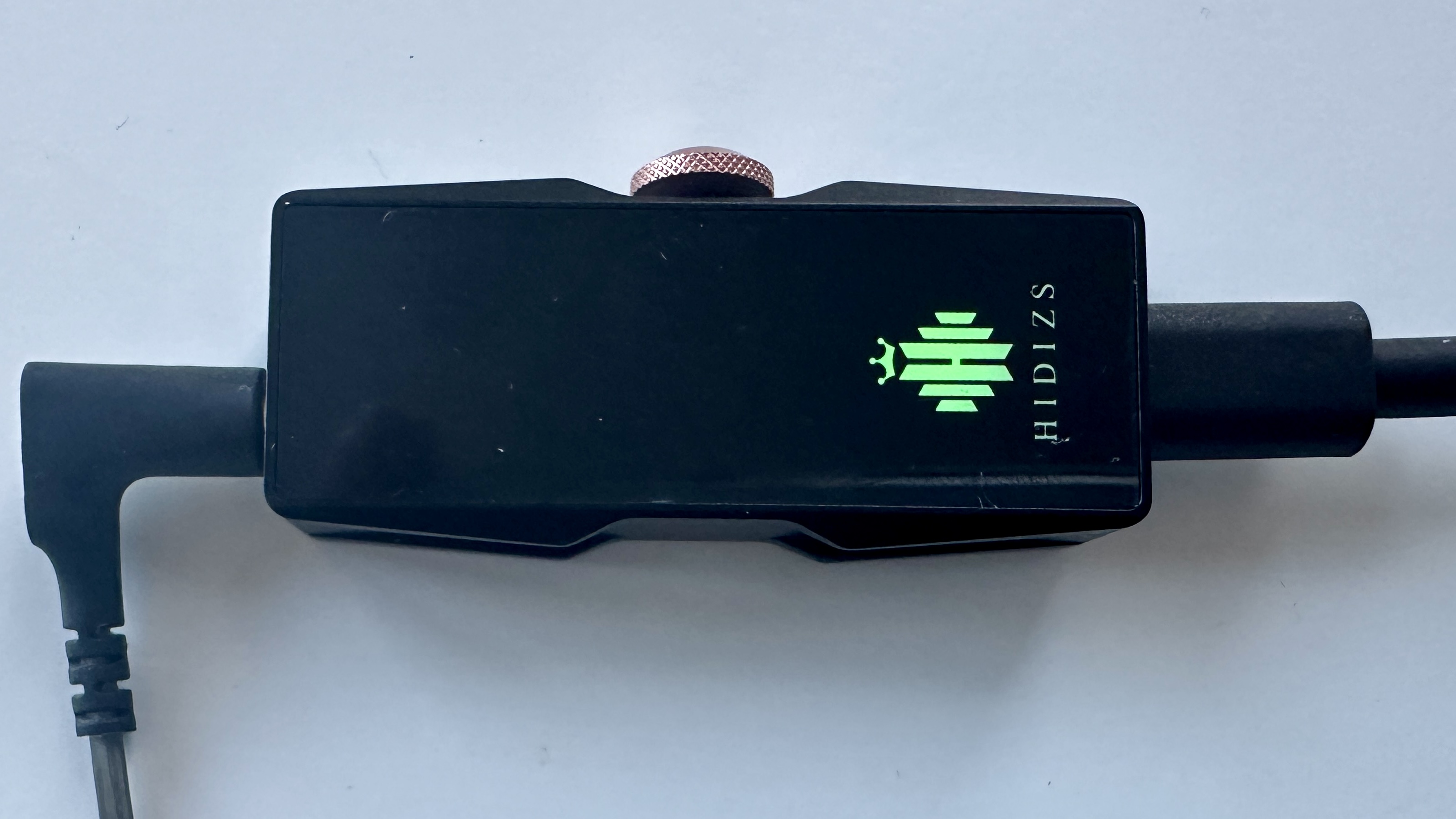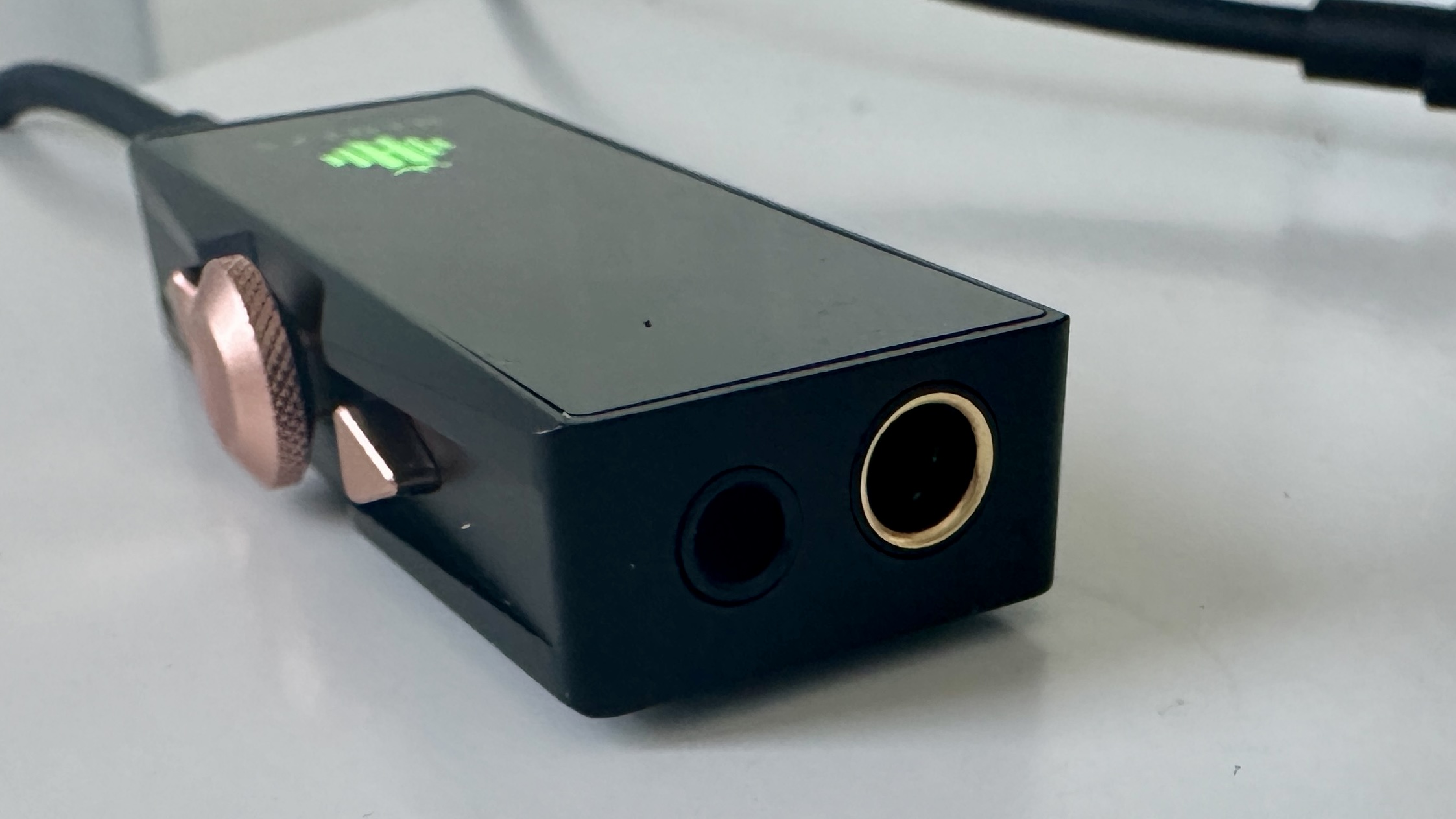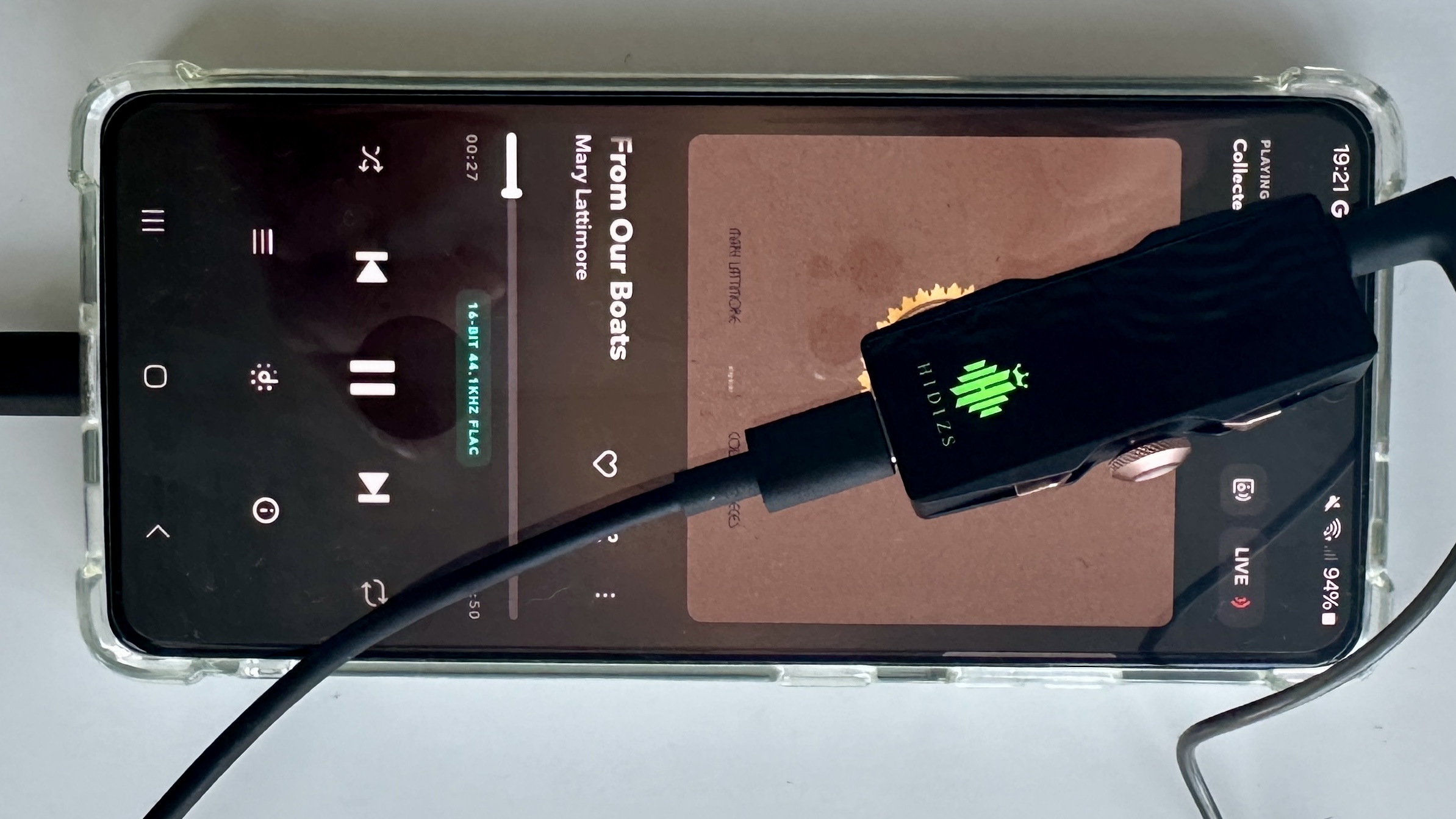TechRadar Verdict
A fine idea in principle and, in many ways, a fine product in execution – but there are some quirks to the way this affordable USB DAC/headphone amp performs that make it an acquired taste.
Pros
- +
Quite open and nicely detailed sound
- +
Impressive specification
- +
Small, light and properly built
Cons
- -
Top end reproduction is thin and quite relentless
- -
Majority of filter options impede the sound
- -
Dislikes small and/or compressed audio files
Why you can trust TechRadar
Hidizs S8 Pro Robin: Two-minute review
The idea of taking the crucial business of digital-to-analogue conversion duties away from your smartphone (which has plenty of other stuff to be getting on with) and doing it properly using a dedicated USB dongle is not a new one – our guide to the best portable and desktop DACs is proof. And the idea of making the price of this USB dongle as aggressive as possible is not especially new, either. But Chinese specialist Hidizs thinks that with the S8 Pro Robin, it has perfected the balance between ‘price’ and ‘performance’.
Certainly this little device looks more expensive than it is, both on paper and in the palm. Specification that includes a balanced architecture DAC arrangement from Cirrus Logic, proper hi-res audio 32bit/384kHz and DSD256 compatibility, and balanced and unbalanced outputs all bode well, as do low weight, tidy dimensions and build quality that makes good use of glass and aluminium.
And up to a point, the Hidizs S8 Pro Robin makes good on its promises. The sound it delivers via a pair of Sennheiser IE900 IEMs when compared to that handed over by an Android smartphone and an Apple laptop is altogether bigger, more detailed, better organised and more dynamic. Where all of these things are concerned, it’s an unarguable step forward.
It doesn’t take long to reveal one or two shortcomings, though. The S8 Pro Robin is no fan of the sort of squashed MP3 files that are Spotify’s stock in trade – it makes the compression they have undergone obvious, and compared to the work it does when given something of 16bit/44.1kHz resolution or above to deal with, they sound rather flat and undemonstrative.
And no matter the quality of the digital audio file you ask the Hidizs to deal with, it renders the top of the frequency range thin and hard. Treble sounds are edgy and splashy, and only get edgier and splashier the louder you listen. This skewing of the frequency range makes the S8 Pro Robin sound rather lopsided, and its top-end characteristics are tiring.

Hidizs S8 Pro Robin review: Price and release date
- Released in May 2024
- Priced $79 / £59 / AU$119
The Hidizs S8 Pro Robin USB DAC/headphone amp is available now, having hit shelves (in most regions, at least) in May 2024, and in the United Kingdom it sells for £59. In the United States it goes for $79, while in Australia it costs AU$119.
This is not a lot of money for a USB DAC/headphone amp, it hardly needs saying – our favourites from the likes of Astell & Kern and Helm Audio cost well into three figures. But then again, a bargain is only a bargain if it’s fit for purpose…
Hidizs S8 Pro Robin review: Features
- 32bit Cirrus Logic DACs
- 3.5mm and 4.4mm outputs
- Supports up to 32bit/384kHz and DSD256 resolutions
Yes, the S8 Pro Robin is small and affordable. But that hasn’t prevented Hidizs from including quite a number of highlights where features are concerned.
For example, the S8 Pro Robin is compatible with pretty much any operating system – attach it to a source of music using the USB-C slot on the bottom and it can play nicely with Windows, every Apple OS, Android and Harmony. And at the opposite end of its little chassis there are both 3.5mm and 4.4mm output sockets - so headphones with balanced or unbalanced terminations can be connected.
It’s in between, though, that the real action is. The Hidizs uses balanced DAC architecture via a couple of 32bit Cirrus Logic CS43131 chipsets, and this allows it to support PCM up to 32bit/384kHz resolution and DSD256. Which means it has its Hi-Res Audio certification and the badge to prove it.
Six digital filters offer a small degree of input into the eventual sound of the S8 Pro Robin – these can be accessed by simultaneously pressing the ‘volume up’ and ‘volume down’ buttons on the side of the chassis. The indicator light on the glass front panel briefly flashes in one of six different colours to let you know which particular filter you’ve selected, before it reverts to a colour that indicates the type and size of digital audio file you’re listening to.
Features score: 5 / 5

Hidizs S8 Pro Robin review: Design
- Aluminium frame
- 58 x 23 x 11mm (HxWxD)
- 17g
Hidizs has done the sensible thing, and made the S8 Pro Robin as small and light as realistically possible. At just 17g you won’t even notice it in your pocket, and at 58 x 23 x 11mm (HxWxD) it’s about as unobtrusive as these things ever get.
It’s nicely built and finished, too. The frame is aluminium, and the front and back panels are of glass - it’s quite a tactile little thing. On the front there’s an illuminated company logo, and on one side three little control buttons. The bigger button in the centre is ‘play/pause’, and it has a volume control on either side. Press both ‘volume up’ and ‘volume down’ together and you can cycle through your filter options.
Design score: 5 / 5

Hidizs S8 Pro Robin review: Sound quality
- Enough power to drive even quite tricky headphones
- Open and detailed presentation
- Insubstantial top end can get tiring
The most important job the S8 Pro Robin has to do is make your headphones (and we truly hope you've chosen something from our best wired earbuds or best wired headphones buying guides here) sound better than when they’re plugged directly into your laptop or smartphone – and it can most certainly do this. Plugged into an Apple MacBook Pro or a Samsung Galaxy S21 Ultra at one end and a pair of Sennheiser IE600 at the other, the difference the Hidizs can make to your experience is significant.
A 16bit/44.1kHz FLAC file of Mary Lattimore’s We Wave From Our Boats sounds fuller, more open and quite a lot more detailed in every department. There’s greater heft to low frequencies, a more spacious rendering of the midrange and a whole lot more bite and attack at the top of the frequency range (which, as I’ll get to, is not an entirely positive trait). Dynamic headroom is improved, soundstaging is more convincing, and there’s greater positivity to the way rhythms are expressed.
Move upwards in resolution from there and all of these positives continue to apply. Go in the other direction, though, with a listen to a 320kbps MP3 file of Idles’ Never Fight a Man with a Perm and the S8 Pro Robin can’t hide its dissatisfaction. Its dynamic response is underwhelming, and the overall presentation is, when compared to what it’s capable of with bigger files, flat and undemonstrative. To say that it doesn’t sound like much of an improvement on the unassisted sound of the source players tells you all you need to know.
Still, it’s simple enough to avoid this just by avoiding listening to horribly compressed content from Spotify’s free tier. What’s impossible to avoid is the hard, unyielding nature of the Hidizs’ high-frequency reproduction. The character of the treble sound is at odds with the rest of the frequency range, and the thin, insubstantial top end is tiring and ultimately not especially pleasant to listen to. And don’t, whatever you do, turn the volume up too far – the relentless nature of the high-end reproduction here is just compounded by loudness.
And it’s also worth noting that this top-end unpleasantness is exacerbated by the majority of the filter options that are available here. In fact, there’s only one filter (called ‘deem phasis filter’ on the Hidizs website – I suspect it’s actually a de-emphasis filter, and its corresponding colour on the fascia is blue) that gets anywhere close to calming the DAC’s treble response – and consequently that’s the one I selected when conducting this test.
Sound quality score: 3 / 5

Hidizs S8 Pro Robin review: Value
In some ways, the Hidizs S8 Pro Robin represents unarguable value. For not very much money at all, it can turn your smartphone or laptop into a much more viable source of music, and as such is a gift for your wireless headphones.
Sonically, though, it’s not quite the finished article – and anyone who’s especially sensitive to high-frequency sound is unlikely to enjoy the way it goes about things. All of which means it probably only offers middling value for money.
Value score: 3 / 5

Should you buy Hidizs S8 Pro Robin?
Buy it if...
You want to up your mobile listening game without breaking the bank
In most respects, the difference the S8 Pro Robin makes to the sound of an ordinary smartphone is both positive and significant.
You enjoy some input into sound quality
There are half a dozen filters available here that affect the sound of the S8 Pro Robin – but not all are forces for good.
You have wired headphones
There are both balanced and unbalanced output sockets here, which makes the Hidizs ideal for wired headphone fanciers…
Don't buy it if...
You’re after perfectly balanced sound
The treble response here sounds like it belongs to a different product entirely.
You mostly listen to 320kbps MP3 files or similar
The Hidizs can’t hide its irritation with content like this, so it’s best avoided.
Your headphones are bright or toppy
The S8 Pro Robin is quite bright and toppy enough all by itself, so there’s not much to be gained by provoking it.
Hidizs S8 Pro Robin review: Also consider
Helm Audio Bolt USB DAC
Yes, it’s a fair bit more expensive than the Hidizs – but the Helm Audio Bolt USB DAC/headphone amp is a fair bit better. In terms of what it does and how, there’s very little difference between the two products, but in terms of sound quality (especially) and tolerance of smaller file sizes (somewhat) the Bolt is quite obviously the superior device. Which, when you consider the difference in price, is probably just as it should be.
Read our full Helm Audio Bolt USB DAC review
How I tested the Hidizs S8 Pro Robin
- With an Apple laptop and a Samsung smartphone
- With content from Spotify and Tidal
- Connected to Sennheiser IE600 headphones via the balanced output
As a process, there’s really not much to describe here. For the best part of a week I listened to the S8 Pro Robin while it was connected to either an Apple MacBook Pro or a Samsung Galaxy S21 Ultra using the USB-C input – Sennheiser IE600 wired in-ear headphones were connected to the 4.4mm balanced output. And then I listened to a variety of music, of a variety of genre and a variety of file types and sizes, from the Spotify and Tidal apps loaded on to both devices.
First reviewed September 2024
Simon Lucas is a senior editorial professional with deep experience of print/digital publishing and the consumer electronics landscape. Based in Brighton, Simon worked at TechRadar's sister site What HiFi? for a number of years, as both a features editor and a digital editor, before embarking on a career in freelance consultancy, content creation, and journalism for some of the biggest brands and publications in the world.
With enormous expertise in all things home entertainment, Simon reviews everything from turntables to soundbars for TechRadar, and also likes to dip his toes into longform features and buying guides. His bylines include GQ, The Guardian, Hi-Fi+, Metro, The Observer, Pocket Lint, Shortlist, Stuff T3, Tom's Guide, Trusted Reviews, and more.

